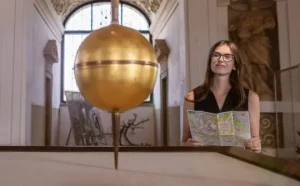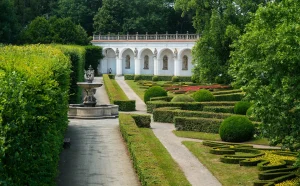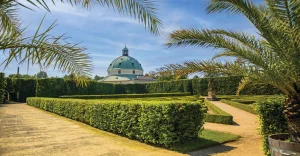The Flower Garden – or Would You Prefer a Libosad?
Regular visitors know that from spring to autumn, Kroměříž bursts into full colour thanks to blooming plants. Some places even carry flowers in their name – most notably the Flower Garden (Květná zahrada), the most valuable of Kroměříž’s UNESCO-listed sites. It represents a pinnacle of 17th-century European garden design, comparable to the gardens of Versailles. Its original name, Libosad (“Pleasure Garden”), speaks to the delightful moments spent in this park.
The Flower Garden attracts visitors throughout the year – as early as February, it hosts the traditional camellia exhibitionin the Great Greenhouse, followed by blooming and fragrant citrus trees in the Palm Greenhouse. In late April and early May, the Dutch Garden comes alive with tulips, and in June, the first ornamental flowerbeds appear in front of the Colonnade. The garden’s vibrant summer palette and autumn hues draw tens of thousands of visitors each year.
The Rotunda and Foucault’s Pendulum
At the heart of the garden stands the Rotunda, whose interior is richly decorated with mythological scenes inspired by Ovid’s Metamorphoses, and details that create a powerful atmosphere. At its centre hangs Foucault’s pendulum, demonstrating the Earth’s rotation on its axis. It is a replica of the original pendulum suspended by physicist Jean Bernard Léon Foucault in the dome of the Paris Pantheon in 1852. The Kroměříž pendulum was installed in 1908 at the initiative of local grammar school professor, physicist and astronomer František Nábělek, during the Jubilee Economic and Industrial Exhibition marking the 60th anniversary of Emperor Franz Joseph I’s reign. It is one of only four pendulums of its kind in the world.
The Colonnade: A Gallery of Gods and Mythical Figures
An essential part of the Flower Garden is the 244-metre-long colonnade, or arcade gallery. Originally serving as a grand entrance, it was also designed as a sculpture gallery. The statues were created in the second half of the 17th century as copies of famous classical works from Roman collections. Throughout the garden, there are 44 full-figure statues and 46 busts depicting ancient gods and goddesses, mythological beings and heroes, and figures from ancient history.
Other architectural elements of the garden include labyrinths, water features, a bowling alley, and the so-called Strawberry Hills. All of this is enclosed by tall, long hedges planted in triangular layouts. Surrounding the central area are decorative and functional zones, including the Orangery, Dutch Garden, greenhouses, farmyard, pheasantry, Rabbit Hill, and aviary.
Thanks to its architectural harmony and scale, the Flower Garden is a masterpiece unlike any other in the world.



